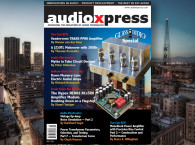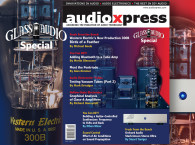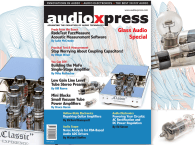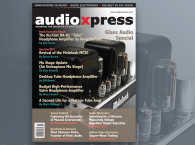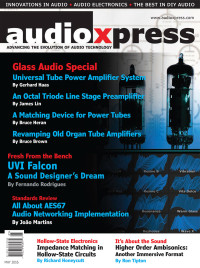 Are you interested in tube projects? Then audioXpress May is for you. There’s amps and preamps for everyone in the best DIY tradition of Glass Audio. audioXpress May also offers innovation in new technologies, from software to audio networking and immersive audio, and this issue includes a nice combination of all these topics.
Are you interested in tube projects? Then audioXpress May is for you. There’s amps and preamps for everyone in the best DIY tradition of Glass Audio. audioXpress May also offers innovation in new technologies, from software to audio networking and immersive audio, and this issue includes a nice combination of all these topics.Now available for download, the audioXpress Glass Audio Special is back with articles to please any tube enthusiast. There’s a powerful and versatile preamplifier, a great hi-fi amplifier project based on revamping old organ tube amps, a tube-matching device, and some great advice on hollow-state circuits. For anyone committed to building tube amplifier projects, this issue also describes a universal tube power amplifier system, which can be easily adapted for musical instruments or hi-fi applications.
Let’s start with the Universal Tube Power Amplifier System, basically a DIY foundation from which to try various circuit configurations before building your next hollow-state project. This expanded and revised article, was originally published in German in Elektor’s Roehren Sonderheft 3 (April 2007) and is a great introduction to the subject and a reference for anyone who wants a concise overview of the technology, now available for the first time in English.
Next, there’s the “Octal Triode Line Stage Preamplifier” by James Lin. This unique line stage preamplifier was designed to match the rest of Lin’s own system - which audioXpress has been publishing over the years - and will probably please everyone looking for an updated and versatile unit.
In “A Silk Purse,” Bruce Brown describes his experience with revamping old organ tube amplifiers, which can result in great hi-fi units. The article details an amplifier project that began with a used Model G series amplifier from the 1950s, and another Model H for a second channel. These tube organs can still be found and are commonly known as Hammond/Jensen amplifiers. They were used as the main power amp/power supply in many small home and church organs and are very well-built. The final result will captivate anyone into tubes.
In “The Beast Matcher,” Bruce Heran describes a project for matching tubes that can also be used for initial “burn-in.” As the author explains, “anyone who designs and builds vacuum tube amplifiers will want to build this device, which can help you find matched sets of tubes. I know that matched sets of tubes are available. I also know that the method and quality of the matching is quite variable. Since Class-A amplifiers operate at fixed values of current, it seem logical to me to devise something that would simulate the operating conditions of the amplifiers. This would allow for accurate measurement of the tubes parameters and as a side feature allows for a “burn in” period.” The device enables testing four tubes at a time.
And of course, our regular column on Hollow-State Electronics always offers great tube-related content. In this issue, Richard Honeycutt discusses “Impedance Matching in Hollow-State Circuits and Equipment,” a subject that, as he explains, “is one of the least understood concepts.”
But even our Glass Audio special cannot entirely focus on a single subject. Our Standards Review column continues to look at Audio Network Development, this time with an important overview of AES67, the high-performance streaming Audio-over-IP (AoIP) interoperability standard. Because it is important to explore all options for audio networking development and implementation in new audio products, one of the most exciting technology developments this industry has seen in many years.
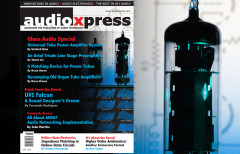 To make things truly interesting — and making good on our promise to expand audioXpress — we also feature a great review of the UVI Falcon, a French software musical instrument that defies everything possible and available until now for music creators, producers, and sound designers. Within this extremely powerful software, there’s a world of possibilities with solid foundations on audio, sampling, and all types of sound synthesis. As Fernando Rodrigues describes Falcon, this is a “synthesizer workstation powerhouse,” or “a modular system — with deep sampling roots.”
To make things truly interesting — and making good on our promise to expand audioXpress — we also feature a great review of the UVI Falcon, a French software musical instrument that defies everything possible and available until now for music creators, producers, and sound designers. Within this extremely powerful software, there’s a world of possibilities with solid foundations on audio, sampling, and all types of sound synthesis. As Fernando Rodrigues describes Falcon, this is a “synthesizer workstation powerhouse,” or “a modular system — with deep sampling roots.”And if software musical instruments are currently among the industry’s most innovative areas, so are immersive audio applications. In his ongoing series, Ron Tipton continues to explore Higher Order Ambisonics (HOA), as another immersive application, including resources and ways to experiment with HOA soundscapes.
The May 2016 issue is now available for download at www.gotomyxpress.com
Of course you can also subscribe here www.audioxpress.com/page/audioXpress-Subscription-Services.html
And you can also buy a single printed issue at www.cc-webshop.com





